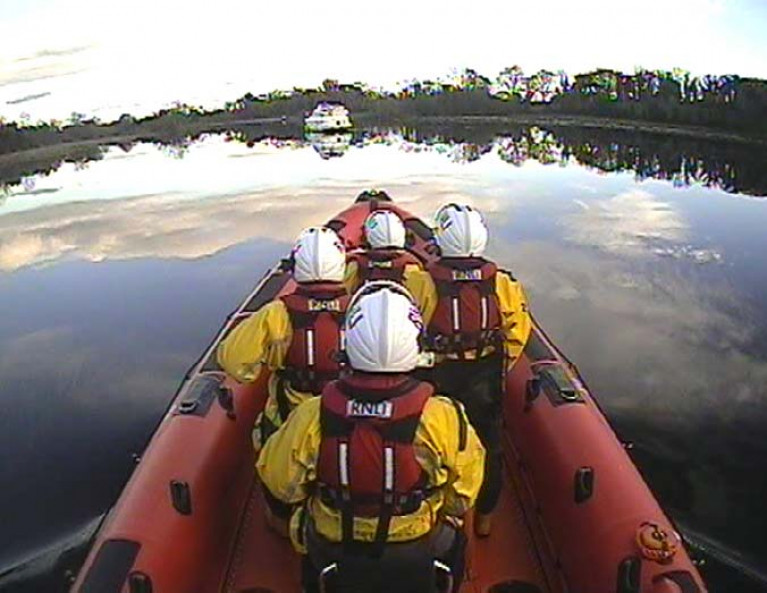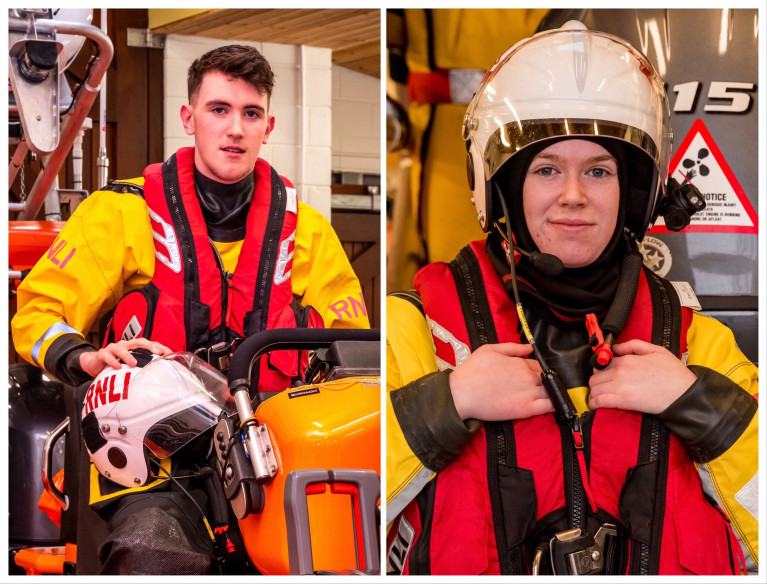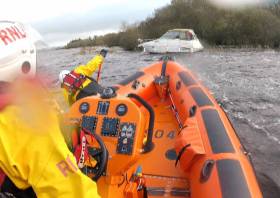Displaying items by tag: Carrybridge
Carrybridge Lifeboat Assists Five on Grounded Sports Cruiser
Carrybridge RNLI’s inshore lifeboat and rescue water craft were launched yesterday afternoon (Saturday 28 August) to assess a vessel in distress with five people on board.
The sport cruiser had run aground some two miles upstream from Bellanaleck in the vicinity of Tamlaght Bay.
Upon arrival, the lifeboat crew assessed the vessel and those on board, and determined that the boat was slightly aground in its present position.
With the owner’s permission, the cruiser was refloated and an alongside tow was set up to bring it into deeper water.
Further checks were carried out and the vessel was found to be in perfect working order before it was allowed to continue its journey.
Speaking following the callout, Chris Cathcart of Carrybridge RNLI offered advice for boat uses this UK bank holiday weekend.
“We would ask that everyone have a means of calling for assistance if you find yourself in trouble, have lifejackets for all on board and plan their journey using the relevant charts.
“If you see someone in trouble on the water or are in difficulties yourself the number to dial is 999 or 112 and ask for the coastguard.”
At 6.30 pm on Saturday 29 May, Carrybridge RNLI’s inshore lifeboat, Douglas Euan & Kay Richards was launched to a vessel with two people on board, which had run aground approx. 1 mile North East of Tiraroe public jetty.
Winds were North Westerly, Force 1. Visibility was excellent.
The lifeboat arrived with the casualty vessel which they found had run aground in shallow water. The volunteer crew checked the wellbeing of the people onboard the casualty vessel and the vessel itself and found all were safe and well. The boat was not taking on any water.
With the owner’s permission, a towline was established with the vessel and it was refloated and towed out to the main navigation channel.
After further maintenance checks were carried out, it was found that the vessel was able to proceed on its onward journey.
When the RNLI crew were about to assist the first casualty vessel, a second vessel also temporarily ran aground in the same vicinity of the shallows. It managed to refloat itself and the lifeboat crew signalled for it to come alongside so that they could check if it was ok.
The casualty vessel with two persons on board noted they had temporarily run aground, and when checked it was established that the crew onboard were safe and well and the vessel itself was undamaged. It proceeded on its onward journey.
Carrybridge RNLI Assist Grounded Cruiser on Lough Erne
At 5.02 pm on Saturday 22 May, Carrybridge RNLI’s inshore lifeboat at Enniskillen on Lough Erne was launched to a vessel with one person on board which had run aground approxmayelt one mile south of Belleisle Estate.
Winds were South Westerly, Force 2. Visibility was good with overcast conditions.
The lifeboat arrived at the casualty vessel and no water ingress found.
The water tank on the boat was emptied to assist the crew in refloating the vessel. With the owner’s permission, a tow was established, and the vessel was refloated and towed to deeper water. The vessel was then able to continue its journey.
Speaking following the call out, Chris Cathcart, Lifeboat Helm at Carrybridge RNLI advised all boat users: ‘‘As we enter the busy time of the year we would ask that everyone have a means of calling for assistance if you find yourself in trouble, have lifejackets for all on board and plan their journey using the relevant charts. If you see someone in trouble on the water or are in difficulties yourself the number to dial is: 999 or 112 and ask for the Coastguard.’’
Two Callouts for Carrybridge RNLI Lifeboat on Lough Erne
At 3.45 pm on Sunday 25 April, Carrybridge RNLI’s inshore lifeboat, Douglas Euan & Kay Richards and Rescue Water Craft (RWC) was launched to a vessel with two people on board, which had encountered engine difficulties approx. 2 miles north of Knockninny on Lough Erne.
Winds were North Westerly, Force 1. Visibility was excellent.
The lifeboat and RWC arrived with the casualty vessel which had drifted close to the shoreline. The volunteer crew checked the wellbeing of the people on the casualty boat and found they were safe and well. With the owner’s permission, a tow was established with the casualty vessel and the boat was then towed back to a private marina.
Just as the volunteer crew were returning at 5.00 pm to the lifeboat station at Carrybridge, Belfast Coastguard requested for both the lifeboat and RWC to assist a second vessel with 5 people on board which had run aground approx. 1 mile North East of Naan Island.
 A second vessel with five people on board had run aground approx. one mile North East of Naan Island
A second vessel with five people on board had run aground approx. one mile North East of Naan Island
The people onboard the casualty vessel were found to be safe and well, and due to the shallow water conditions, the volunteer crew carefully transferred them all over to the lifeboat. This allowed the grounded vessel to be refloated and towed back to the Carrybridge Public Slipway.
Speaking following the call out, Stephen Scott, Lifeboat Operations Manager at Carrybridge RNLI advised all boat users: ‘‘As the Bank holiday approaches please take time to plan your journey with the relevant charts, lifejackets for all onboard and a means of calling for assistance if you find yourself in trouble. If you see someone in trouble on the water or are in difficulties yourself the number to dial is: 999 or 112 and ask for the Coastguard.’’
Carrybridge Lifeboat Station was started in 2002 on Upper Lough Erne. It currently operates an Atlantic 85 inshore lifeboat and a Rescue Water Craft
Only a few days after Carrybridge RNLI which operates on Upper Lough Erne, received a generous donation from the Enniskillen Royal Boat Club, its Atlantic 85 Inshore lifeboat answered a shout yesterday (7th) to help a vessel with two people onboard which had developed engine difficulties.
The Douglas Euan and Kay Richards and a Rescue Watercraft arrived with the casualty vessel near the Share Discovery Village on the eastern shore of Upper Lough Erne.
Winds were South Westerly, Force 2 and visibility was good with overcast conditions. The crew found that the vessel had secured to a navigation marker and the people on the casualty boat were unharmed.
With the owner's permission, a tow was established, and the boat was then towed the short distance to Corradillar Quay.
On returning to the station the crew found a 4m section of a tree floating in the main navigation channel which was posing a significant risk to other water users. The crew were able to remove this from the water to allow for safe navigation.
Speaking following the call out, Stephen Scott, Lifeboat Operations Manager at Carrybridge RNLI advised all boat users: ''At this time of year when there isn't much boat movement on the water it is especially important before setting out to plan your journey, have the relevant charts required, lifejackets for all on board and a means of calling for assistance if you find yourself in trouble. If you see someone in trouble on the water or are in difficulties yourself the number to dial is: 999 or 112 and ask for the Coastguard.''
Carrybridge Lifeboat Station was founded in 2002 on Upper Lough Erne
It’s 580 km from Malin Head to Mizen Head and this was the distance covered by members of the Enniskillen Royal Boat Club in a fund-raising virtual row in aid of the Carrybridge RNLI on Lough Erne and Action Mental Health. The boat club is part of Enniskillen Royal Grammar School and has established itself as one of the top rowing clubs in the UK and Ireland. It is set in the historic school grounds’ Lough Shore site at the Portora Boat House.
Carrybridge lifeboat station is located at the village of Carrybridge on Upper Lough Erne, providing protection for those who use that Lough and its surrounding inland waterways.
The rowers handed over a substantial donation of £3,035.03, raised by the challenge to virtually row, run or cycle the distance of 580km. Shannon Clawson also carried out the return journey.
Stephen Scott of Carrybridge RNLI praised the rowers at ERBC for all their hard work and dedication raising money for both the RNLI and for Action Mental Health. “The funds raised will have a significant impact for the crews at both Carrybridge and Enniskillen and will assist with future lifesaving operations.”
Carrybridge RNLI Lifeboat Volunteers Launch New Online Fundraising Page
As the RNLI continues to operate as normal during the Covid-19 pandemic, the charity is still unable to fundraise out in person in the community.
With more people needing the lifeboat crews as they stay home, support from the public is more important than ever — and Carrybridge RNLI in Northern Ireland is one unit that has risen to the challenge by making it easier for people to back their vital work.
The RNLI operates two lifeboat stations for Upper and Lower Lough Erne, at Carrybridge and Enniskillen respectively, and has seen a drop in funds raised locally in 2020 as traditional fundraising activities had to be cancelled.
In many cases, when the lifeboat pager goes off, volunteers will need to abandon homeschooling or work and head to the lifeboat station to answer the call for help.
Stephen Scott, lifeboat operations manager at Carrybridge RNLI, says: “We couldn’t do what we do without the support of the public. The RNLI has experienced a drop in funds locally, but we are rescuing more people than ever before.
“We are facing challenging times and are calling on people to consider making a donation this year to ensure we can continue saving lives on inland waters.
“We have moved our fundraising online in these challenging times and set up a JustGiving page for the lifeboat station where people can donate directly to their local lifeboat station in Carrybridge.”
To support the RNLI at Carrybridge, helping to ensure the charity’s brave volunteers can continue saving lives on Lough Erne, visit their JustGiving page HERE.
Carrybridge RNLI Assist One Person on Motor Cruiser Aground
At 4.17pm on Wednesday 4 March, Carrybridge RNLI’s inshore lifeboat, Douglas Euan & Kay Richards, and Rescue Water Craft (RWC) was launched to a vessel with one person on board which had run aground approx. 2 miles North of Carrybridge.
Winds were North West, Force 1. Visibility was good with clear conditions.
The lifeboat and RWC arrived with the casualty vessel which had run aground due to the high-water levels at present. The volunteer crew checked the wellbeing of the passenger on the casualty boat and the vessel itself and found all was were ok.
With the owner’s permission, a tow was established with the casualty vessel and it was refloated into deeper water. The craft was checked for damage and all was found to be in order. The vessel with its one person onboard was able to continue on its onward journey.
Speaking following the call out, Chris Cathcart, Volunteer Lifeboat Press Officer at Carrybridge RNLI advised all boat users: ‘‘At this time of year when the water levels are higher than normal, it is especially important before setting out to plan your journey, have the relevant charts required, lifejackets for all on board and a means of calling for assistance if you find yourself in trouble. If you see someone in trouble on the water or are in difficulties yourself the number to dial is: 999 or 112 and ask for the Coastguard.’’
Two volunteer crew members at Carrybridge RNLI lifeboat station have had a vital part of their crew training funded by Lloyd’s Register Foundation.
Shani Spence from Lisbellaw and Joe Donnelly from Enniskillen, recently travelled to the RNLI College in Poole, Dorset, to complete the charity’s Crew Emergency Procedures course.
The course sees volunteer crew being trained in a variety of crucial subjects such as how to deal with fires aboard lifeboats, how to ‘abandon ship’ in the event of an emergency (with a 4m jump into water), team survival swimming, coping in a life-raft in simulated darkness, how to right a capsized inshore lifeboat, and the importance of lifejackets. It also includes sessions on the correct use of flares, fire extinguishers and throw bags.
Talking about the training, Shani, who volunteers as a crew member, said: ‘This course definitely helped with my confidence in an actual emergency as I got to have a hands-on approach and see how it all feels in real life, meaning it will be a little less scary if anything went wrong.’ Joe, who also volunteers as a crew member, said: ‘It was a very good and intriguing course which I enjoyed very much.’
Shani and Joe’s training took place in the Sea Survival Centre at the RNLI College, where they were joined by other RNLI volunteer crew members from around the UK and Ireland.
The training was funded by Lloyd’s Register Foundation, a charitable foundation that helps to protect life and property by supporting engineering-related education, public engagement and the application of research. The Foundation has committed to funding the RNLI’s Crew Emergency Procedures course for a second 5-year period until December 2020. This additional funding of £1.06M brings their total support for RNLI crew training to just over £2.46M* since 2008. More than 3,000 RNLI volunteer crew members have now received the training thanks to Lloyd’s Register Foundation’s funding.
Alex Evans, Lifesaving Training Manager at the RNLI said, ‘We are so grateful to Lloyd’s Register Foundation for funding this vital part of our volunteer crews’ training.
‘Their support is very important to us and it’s fantastic how, so far, over 3,000 of our crew members have benefitted from Lloyd’s Register Foundation funding this part of their training. As only one in ten of our volunteer crew members comes from a professional maritime background, the Crew Emergency Procedures course is crucial in giving our volunteers the training they need and helping keep them as safe as possible while carrying out rescues. It gives volunteers the confidence to save lives even in the most challenging conditions.’
This donation is the latest in Lloyd’s Register Foundation’s relationship with the RNLI, which was recognised in 2010 when it received the Group Supporter Award from HRH Prince Michael of Kent in recognition of its valuable support of the charity.
Carrybridge Lifeboat Assists Vessel Adrift Near Island In Upper Lough Erne
Carrybridge RNLI’s inshore lifeboat launched yesterday afternoon (Tuesday 12 November) to a vessel adrift close to an island in Upper Lough Erne north-east of Knockninny Marina.
Winds were north-westerly Force 2 when the lifeboat Douglas Euan & Kay Richards arrived on the scene and slowly proceeded to the location of the vessel, with one man on board.
With the owner’s permission, and due to weather conditions pushing the boat onto the island, the lifeboat crew set up a tow line to being the casualty vessel into deeper water and then onwards to the safety of the marina.
Speaking following the callout, lifeboat operations manager Stephen Scott advised all boat users: “Before setting out on your journey, please plan your route and carry out regular checks of their vessels.
“With the constantly changing water levels at this time of year, please be vigilant for floating debris in the water. Also have a means of calling for assistance if you find yourself in trouble.
“If you see someone in trouble on the water or are in difficulties yourself the number to dial is: 999 or 112 and ask for the coastguard.”
Carrybridge RNLI is currently seeking new crew members to join its search and rescue service in Co Fermanagh, and will be hosting an open evening for all interested candidates at the lifeboat station next Thursday 21 November from 7pm.

































































